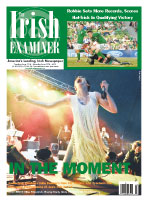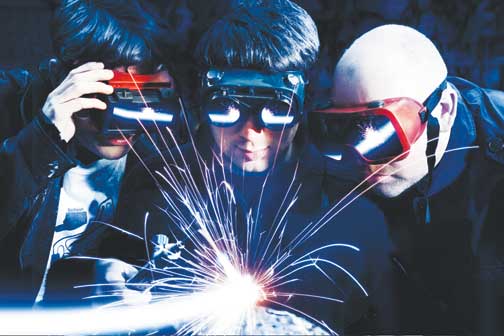


SERVICES
Tuesday September 15, 2009
Keeping Tradition Alive
Putting A Spark In Traditional Music: Lau By Joe Kavanagh For most amongst us, the term 'Celtic traditional music' is synonymous with Ireland, particularly in the context of a post-Riverdance landscape, but the genre has long maintained a strong presence in several other countries throughout the world. Regions such as Brittany in France, Galicia in Spain and Cornwall in England each have their own distinct brand of Celtic music, while countries such as the Isle of Man and Wales have also maintained independent musical traditions with their own unique style. In more recent times North America has also developed its own spirited take on Celtic music, with thriving hotbeds of traditional music in places like Newfoundland and New York City, and few can deny its influence on genres such as Bluegrass and Country music. Undoubtedly though, Scotland remains the most influential country outside of Ireland in terms of Celtic traditional music, with a thriving musical culture that has given the world such Celtic music giants as Runrig and the Tannahill Weavers. Only two albums into a career that already has them vying for greatness, a new Scottish act is threatening to overshadow all but a hallowed few on either side of the Irish Sea, with a sound not only maintains a tradition that has run through thousands of years but takes it in ever more new and exciting directions. Lau might just be the most exciting thing to happen to Celtic music in the last ten years. It is often said that musical acts are greater than the sum of their parts, and while the same statement is certainly true of Lau; it is made all the more extraordinary given the considerable quantity that each virtuosic member of this precocious three-piece accounts for in his own right. A veritable example of lighting in a bottle, their coming together offers a prime example of the kind of synergy that can occur when preternaturally talented people come together to pool their substantial gifts in pursuit of a common goal, but in order to know something of the whole, it is crucial to understand something of its constituent parts, as part of a story that begins on three disparate paths. Fiddle-player, Aidan O'Rourke grew up in Oban, on Scotland's wild western shoreline, a place that is as stark as it is beautiful, in a region that has long been celebrated for its strong musical custom. As a teenager he won two national titles in fiddle competitions, before signing on with folk group Caledonia Ramblers, and touring North America shortly after turning 15-years-old. Over the next decade his talent would see him called upon to appear on over 60 albums as a session musician, while he also formed noted act, Tabache with multi-instrumentalist, Claire Mann. When not collaborating with others, he worked on his own material, producing a solo album, Sirius, in 2003, and creating a piece of music titled, Mantra Alba, which was specially commissioned by the Scottish government to celebrate a visit by the Dalai Lama, in addition to his work with Blazin' Fiddles, all of which established him as one of the most distinguished faces on the Edinburgh music scene. Befriending O'Rourke some 12 years ago, another major talent within Edinburgh's musical environment was singer/multi-instrumentalist, Kris Drever, whose own body of work was equally impressive. The son of folk royalty, his father Ivan Dreever was a member of acclaimed act, Wolfstone, whose compositions had been recorded by the Dubliners and even appeared in Hollywood movies such as Good Will Hunting. While his parents were originally from Glasgow, they relocated to the remote Orkney Islands, where they raised their family and it was not until 1995, that their son moved to Edinburgh. Like O'Rourke, he plied his trade as a session musician, touring the world several times over with acts like his father's musical project Celtic Fusion, his own act Fine Friday and as a band member with folk superstar, Kate Rusbie. The final element of Lau carried no less a distinguished musical résumé but emerged from a rather more unlikely musical background, vis-à-vis Celtic traditional music. Martin Green was born in the tough English steel-town of Sheffield, before his family moved to the rather more sedate surrounds of Cambridge, where he, along with his siblings, was encouraged to learn a musical instrument from an early age. In contrast to most kids, who would chose guitar or drums under such circumstances, Green settled on the somewhat less glamorous accordion, incorporating a number of musical styles as he essentially played with any group of musicians that would have him. He went on to study under famed accordionist, Alberto Santilly, and even traveled to Hungary as a teenager to learn the gypsy-style of playing from Janos Long. His conscientiousness soon stood him in good stead when he hooked up with singer, Eliza Carthy, with whom he went on to make several albums, garnering a Mercury Muisc Prize nomination along with way. United in a deep desire to bring something new to a genre that occasionally tends to languish in the prison of its own past, the three men
finally set to work on a project that sought to expand the boundaries of folk music without losing any of its vitality and soul. Like his eventual band-mates, he also worked with his own experimental outfit, Green Machine, and attained attention as a composer that has seen his work performed throughout the UK, and even as a centre-piece at the Glastonbury music festival. All three men eventually became acquainted with each other on the flourishing Edinburgh scene, though it was not until Green moved there permanently in 2004, that the three began working together regularly. United in a deep desire to bring something new to a genre that occasionally tends to languish in the prison of its own past, the three men finally set to work on a project that sought to expand the boundaries of folk music without losing any of its vitality and soul. Taking the name Lau (their own derivation of the Orcadian word "lowe" which means "natural light"), the trio released their debut album, Lightweights and Gentlemen, in March of 2007, to near universal acclaim. Mixing original compositions with their own distinct take on classics like Liam Clancy's Free Born Man, the album incorporated a dizzying array of influences, from jazz to African rhythms, into one cohesive sound all of their own. Armed with melodies that manage to remain instantly engaging despite their innovation and complexity, the album proved a hit with critics across all musical genres, such was the virtuosity evident within. Backing up this opening salvo was a live show so explosive, appealing and quasi-spiritual that venues frequently locked their doors after the official gig and begged the band to continue playing for as long as they wished. This confluence of talent, desire and originality was enough to provoke Channel 4 Music to declare them to be "...quite frankly the best band in the world right now". If such praise appeared somewhat hyperbolic, it was given further sustenance with the release of their second studio album, Arc Light, which hit shelves six month ago and is a sure bet to appear on virtually every music critic's Best of Year list when 2009 draws to a close. A more polished affair, it continues to push the frontier of their sound, dragging an entire genre with it, and managing to pull of the entire trick while still sounding utterly alive with spontaneity. It is a beautifully realized piece of cutting-edge folk that can be appreciated by any fan of music, with an ebb and flow that is positively riveting. If all that weren't enough, it even draws to a close with a sublime version of the Beatles' track, Dear Prudence, which the band initially created for a Mojo magazine compilation to celebrate the 40th anniversary of the White album. It is a work of sufficient power, promise and scope to immediately put the band at the very forefront of Celtic music, setting the bar for all other traditional acts who seek to create something of importance. When the three members of Lau ultimately decided to pass on this torch to the next generation of musicians who arrive in their inspirational wake, it will be in far better state than when they first took it in hand and that surely is the greatest indictment of any custodian of a proud tradition, and an indelible mark of their importance. |
CURRENT ISSUE

RECENT ISSUES


SYNDICATE
[What is this?]
POWERED BY

HOSTED BY

Terms of Service | Privacy Policy
Website Design By C3I






